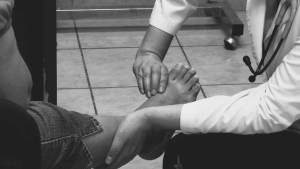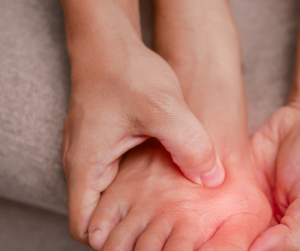If you’ve been experiencing persistent pain in the ball of your foot, particularly between your third and fourth toes, you may be dealing with a condition known as Morton’s neuroma. This is a common cause of forefoot pain that can make everyday activities such as walking or standing progressively uncomfortable.
At the London Foot and Ankle Centre, we frequently see patients who have endured undiagnosed forefoot pain for months or even years. Understanding what causes Morton’s neuroma is the first step toward finding lasting relief.
What Is Morton’s Neuroma?
Morton’s neuroma occurs when the tissue surrounding one of the nerves leading to your toes becomes thickened. This thickening occurs as a response to irritation, pressure, or repeated trauma to the nerve.
The affected nerve becomes inflamed, leading to a sharp, burning pain in the ball of the foot that may radiate into the toes. Patients often describe the sensation as “walking on a pebble” or feeling as though their sock is bunched up under their foot.
Without appropriate treatment, symptoms may worsen over time and patients may require Morton’s neuroma treatment to relieve pain and prevent further deterioration.
Common Causes of Morton’s Neuroma
There is rarely a single cause of Morton’s neuroma; it usually develops from a combination of mechanical stress, lifestyle factors, and sometimes underlying foot deformities. Below are the most common contributors:
Overuse and Repetitive Stress
Jobs or activities that involve prolonged hours of standing, walking, or running on hard surfaces can cause repeated stress on the forefoot. Over time, this continuous pressure irritates the nerve between the toes, leading to inflammation and thickening of the surrounding tissue.
Poorly Fitting Footwear
Footwear is one of the most significant factors in the development of Morton’s neuroma. Tight, narrow shoes that squeeze the toes together, or high heels that push weight forward onto the ball of the foot, are common triggers.
When the toes are compressed, the nerve between them is trapped and irritated, triggering inflammation and discomfort.
Excess Body Weight
Excess body weight increases the pressure placed on the forefoot with every step. Over time, this added stress can contribute to nerve irritation and inflammation, especially if combined with other risk factors such as poor footwear or flat feet.
Maintaining a healthy weight reduces strain on the feet and lowers the risk of developing other foot and ankle problems.
Rheumatoid Arthritis
Inflammatory conditions such as rheumatoid arthritis can lead to changes in the structure of the foot, including joint deformities and swelling around the nerves. These changes may increase the likelihood of developing a neuroma. The chronic inflammation associated with arthritis can also make the nerves more sensitive to irritation.
Altered Foot Function
This is how your foot moves during walking or running, also known as your foot biomechanics. It plays a key role in the health of your nerves and joints.
Flat feet, high arches, or uneven weight distribution can create abnormal pressure across the forefoot. This altered function can pinch the nerve and lead to Morton’s neuroma over time.
Toe Deformities
Structural deformities such as claw, mallet or hammer toes can significantly increase pressure on the ball of the foot. These conditions cause the toes to bend in a way that disrupts normal foot alignment. This places excessive weight on the metatarsal heads and can irritate the nerve between the toes, ultimately leading to neuroma development.
Morton’s Neuroma Treatment
If you suspect you have Morton’s neuroma, your foot and ankle consultant will begin with a detailed discussion of your symptoms and lifestyle, followed by a physical examination. Imaging studies such as X-rays, ultrasound scans, or MRI may be used to confirm the diagnosis and rule out other potential causes of forefoot pain.
Treatment for Morton’s Neuroma depends on the longevity and severity of the symptoms. Initial treatment of Morton’s Neuroma is usually conservative, non-surgical and simple.
The point of methods such as weight loss, calf stretching, changing your footwear, orthotics and corticosteroid injections is to relieve pain and prevent recurrence. If conservative Morton’s Neuroma treatments haven’t helped, further options may be considered.
LFAC specialises in minimally invasive techniques for corrective surgery that can be performed with just local anaesthesia. In some cases, surgeries such as nerve removal, decompression surgery and calf muscle release may be recommended.
One highly effective option is radiofrequency treatment, a minimally invasive procedure that uses electrical energy to generate heat and disrupt the pain signals transmitted by the affected nerve. This technique has proven to provide excellent long-term results for patients suffering from Morton’s neuroma, often eliminating the need for surgery.
At the London Foot and Ankle Centre, we have extensive experience performing radiofrequency treatment, achieving consistently high success rates. For most patients, the procedure offers significant pain relief and a quick return to normal activity levels. If symptoms persist, surgical intervention remains a safe and effective option.
Preventing Morton’s Neuroma
Even after successful treatment, prevention remains essential. Wearing supportive shoes with ample toe room, maintaining a healthy weight, and addressing any biomechanical abnormalities through orthotic support can all help prevent recurrence.
In summary, Morton’s neuroma develops when repetitive stress, poor footwear, or biomechanical imbalances irritate a nerve in the ball of the foot. With expert assessment and advanced treatments like radiofrequency therapy available at the London Foot and Ankle Centre, most patients can expect long-term relief and a return to pain-free mobility.
Why Choose LFAC
At The London Foot and Ankle Centre, we have the most extensive experience of radiofrequency treatment in the UK with consistently excellent outcomes. Most patients achieve long-term pain relief without the need for surgery.
In the small number of cases where radiofrequency treatment does not provide sufficient relief, surgery can still be performed later without additional risk of complications. This makes radiofrequency treatment both an effective first choice and a safe one.
Maintaining good footwear habits, a healthy weight, and addressing any underlying biomechanical issues are still important in preventing symptoms from returning. Supportive shoes with wide toe boxes and cushioning remain the best long-term investment for foot health.
Your consultant will monitor your recovery, address any concerns, and provide guidance for returning to all your desired activities safely. Schedule regular follow-up appointments to ensure your recovery progresses smoothly and safely.


Matthew Solan
This article was reviewed by Mr Matthew Solan, a consultant orthopaedic surgeon. He has been with LFAC since its formation in 2003.


